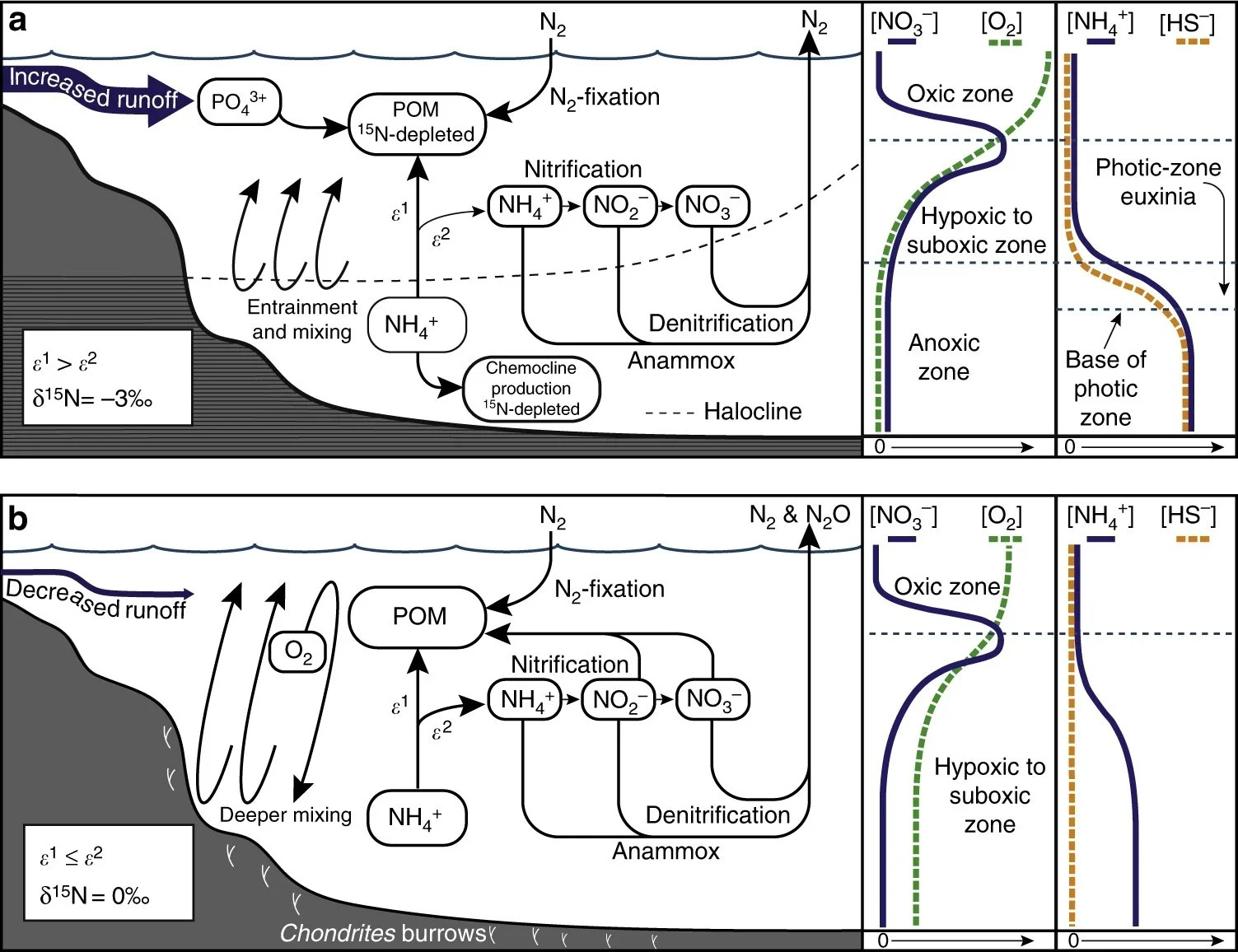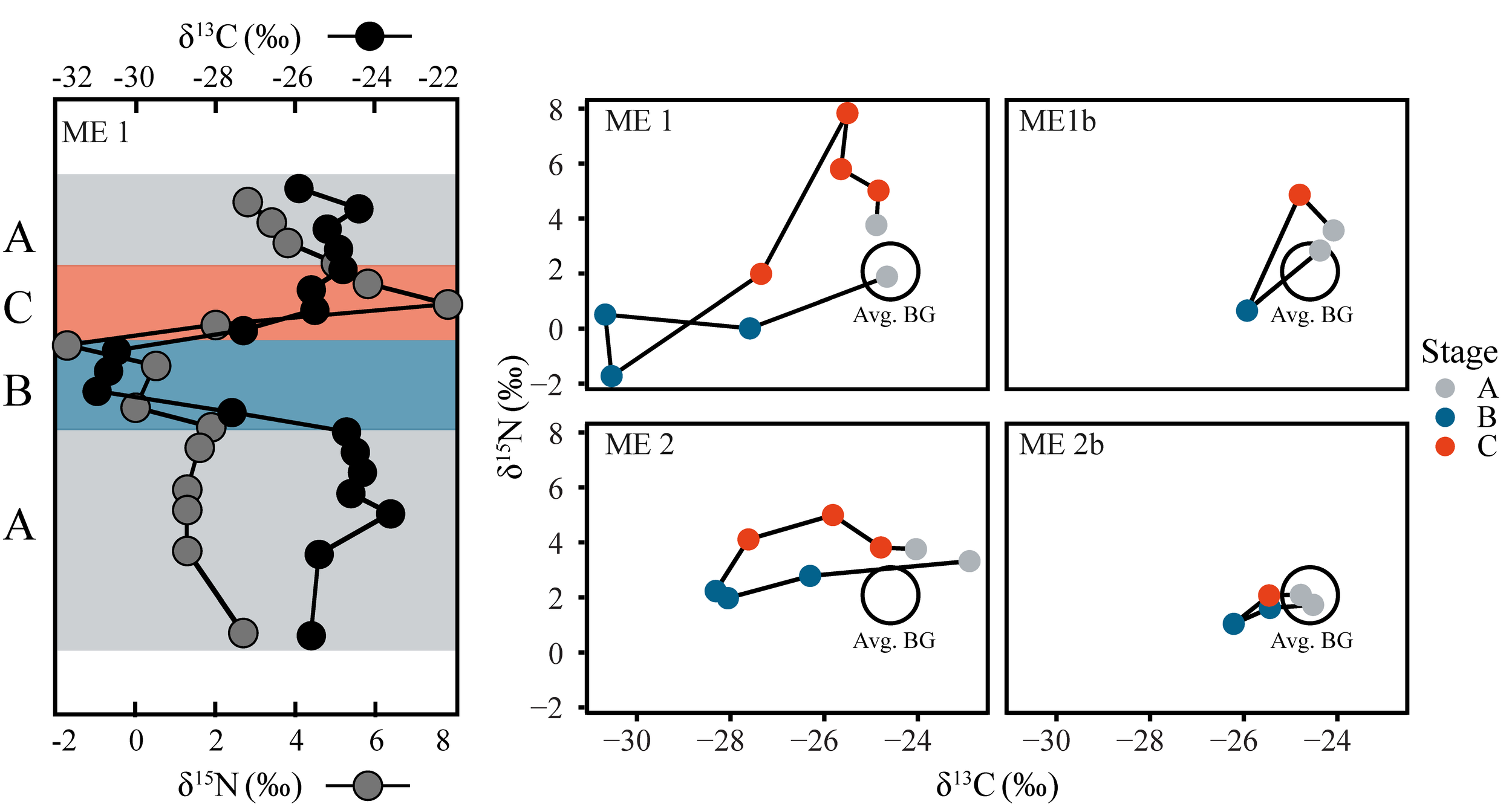Tracing ancient biogeochemistry with Nitrogen isotopes
Biogeochemical nutrient cycling exerts a fundamental control on marine ecosystems, as all organisms have certain basic requirements of carbon, nitrogen, phosphorus, and other trace elements.
Many of the processes that govern the cycling of nutrients in the marine realm have some dependency on redox state, which also controls the form that specific nutrients take. For example, nitrification, the process that converts ammonium to nitrite and nitrate, requires significant oxygen to proceed, whereas denitrification, the major sink of nitrogen in the ocean, is confined to suboxic regions of the water column and sediments. The relative balance of these processes, the rate of nitrogen uptake, as well as the form of nitrogen (ammonium vs. nitrate) being utilized by primary producers, impart distinct isotopic signatures to sedimentary organic matter. Therefore, by analyzing the stable isotopic signatures preserved in sedimentary deposits, we can track the relative changes in how nitrogen is cycled through time in response to environmental changes, such as global or regional climate.
Nutrient cycling in a warming world – the past informs our future
As we look towards an increasingly perturbed modern Earth and atmospheric system, regional zones of hypoxia and anoxia are, and will continue to expand under a warming climate. To better understand how the cycling of essential elements in the ocean will change with warmth and expanding low oxygen conditions, my research looks to ancient anoxic ocean basins during major climate transitions for context. By understanding how climate events affected nutrient cycling in the past, as well as the ecological response to that change, we can begin to make better predictions of how modern systems, such as the rapidly expanding “dead zones” in the Gulf of Mexico and other enclosed basins such as the Baltic, will evolve and impact society.
An example of such an extreme climate transition can be found in the Paleocene–Eocene Thermal Maximum (PETM). The PETM was an interval of rapid warming that was the result of increasing contents of greenhouse gases in the atmosphere that had wide-ranging effects on ecosystems globally. Warming, changes in ocean circulation, and deoxygenation caused a transition to nitrogen cycle to conditions that were most similar to those experienced during Oceanic Anoxic Events of the Mesozoic, which had far-reaching effects on marine ecosystems..
Perturbation to the Nitrogen Cycle During Rapid Early Eocene Global Warming, Nature Communications 9, 3186. https://doi.org/10.1038/s41467-018-05486-w
A modern analog for exotic nitrogen cycling during Mesozoic OAEs
One of the outstanding issues in the study of nutrient dynamics during Oceanic Anoxic Events (OAEs) is the preservation of 15N-depleted nitrogen isotope signals, which are not observed in analogous modern environments. The favored mechanism for δ values below 0 is the utilization of excess ammonium derived from underlying anoxic waters by primary producers. However, there are few modern examples available for testing this hypothesis, due to the overall well-oxygenated state of modern oceans.
A possible analog may be found in chemocline collapse events in Lake Kivu, a meromictic lake in East Africa. A chemocline represents a chemical or redox-related boundary in stratified marine/lacustrine basins, and the specific character of a chemocline can strongly influence microbial ecology and elemental cycling. During times of chemocline stability, an excess of nutrients (specifically phosphate and ammonium) builds up in the deep waters of the lake. When that chemocline is disturbed and the water column mixes those nutrients are released to the photic zone, allowing for the rapid proliferation of primary producers. The utilization of these sub-chemocline derived nutrients imparts distinct isotopic signatures to the biomass that is preserved in coeval sediments, including nitrogen isotope ratios similar to those observed during OAEs. Repeated mixing events that are preserved in sediments that then become compacted and time-averaged, could potentially provide a mechanistic link to the exotic nitrogen cycling signals of OAEs.
Chemocline collapse in Lake Kivu as an analogue for nitrogen cycling during Oceanic Anoxic events. Earth and Planetary Science Letters https://doi.org/10.1016/j.epsl.2020.116459
Extending the Lake Kivu analog to Oceanic Anoxic Events
Though the geochemical signatures of chemocline collapse in Lake Kivu provide an intriguing mechanism to explain the anomalous N-isotope ratios in OAE sediments, the translation of these inherently geologically short events to the timescales relevant to OAEs was still problematic. To investigate how this could be achieved, we first constructed an isotopic box model capable of reproducing the geochemical template seen in Lake Kivu sediments. We then tuned the model to better replicate the degree of 15N-depletion observed during Mesozoic OAEs. We then tuned the model to reproduce some of the more negative values seen during OAEs. We found that the only way we could do this was by ramping up the rates of direct ammonium uptake (NH4+) relative to its oxidation to NO3/NO2 (NOx) during the mixing event intervals.
Further, we devised a sampling function that effectively stacked numerous iterations of a modeled "mixing event" on top of each other in a hypothetical sediment column. We then sampled the stack with some forced stochasticity and various scaling factors to recreate what a geochemical record of these events might look like. Each "sample" was a weighted average of the encompassed points - simulating the homogenization that occurs in sample prep.What we found is that by modulating how things were scaled, and the sampling window, we could pretty accurately recreate (second image) the range and specific character of typical OAE records(first image).
So, what does this all mean? In the modern ocean, NO3 is the dominant N form, and the N cycle and δ15N record are mostly modulated by the balance between N-fixation and incomplete water column denitrification. The big takeaway from our analysis is that under conditions of largely anoxic ocean deep waters (like during OAEs) the N-cycle shifts to a state where deepwater N is dominated by NH4+, and its fate is the dominant control on δ15N record.The periodic build-up of NH4+ under strong redox stratification can then be likened to the charging of a "nutrient capacitor", and its rapid release under chemocline collapse as the "discharge" of the capacitor.The repeated charge-discharge cycles of the "nutrient capacitor" can then be translated into long-term OAE sedimentary records due to the over-representation of the mixing events driven by high nutrient loads and productivity, and typical sampling/processing procedures.
Benjamin T. Uveges, Ann Pearson; Ammonium “nutrient capacitor” model for δ15N signatures associated with marine anoxic events. Geology 2023; doi: https://doi.org/10.1130/G51527.1
Nutrient biogeochemistry during FF-Biotic Crisis
The Frasnian-Famennian Biotic Crisis is counted among the “Big Five” mass extinctions and is marked by two distinct intervals known as the Lower and Upper Kellwasser Events (KWEs) that in many locations are associated with the deposition of organic-rich shales. Sedimentary nitrogen and carbon isotopes offer insight into the biogeochemical processing of nutrients, production of organic matter, and palaeoceanographic conditions during the KWEs. The pattern of δ15Nbulk and δ13Corg values displayed by KWE sediments in the Appalachian Basin of NY suggests that the depth of the chemocline and the degree of water-column stratification exert primary control on both δ15Nbulk and δ13Corg during black shale deposition. In the context of the Frasnian-Famennian biotic crisis, the oscillating redox state and changing temperatures would have likely placed extreme stress on organisms within the marine environment of the AB and IB and may potentially have been a contributing factor to diversity loss over this time period.
Figures are from Cohen and Junium et al. (2021) and Uveges et al. (2019).
Biogeochemical controls on black shale deposition during the Frasnian-Famennian biotic crisis in the Illinois and Appalachian Basins, USA, inferred from stable isotopes of nitrogen and carbon, Palaeogeography, Palaeoclimatology, Palaeoecology. https://doi.org/10.1016/j.palaeo.2018.05.031
Carbon cycle dynamics and ecology revealed by the carbon isotopic composition of single organic microfossils during the Late Devonian Biotic Crisis. Geobiology https://onlinelibrary.wiley.com/doi/epdf/10.1111/gbi.12482













